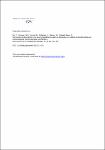Hormonal contraceptive use among adolescent girls in Germany in relation to health behavior and biological cardiovascular risk factors.
Du, Yong
Rosner, Bettina
Knopf, Hildtraud
Schwarz, Sabine
Dören, Martina
Scheidt-Nave, Christa
Purpose: To determine the association between hormonal contraceptive (HC) use, and behavior-related and biological cardiovascular risk factors among teenage girls in Germany. Methods: HC use was assessed among 2,285 girls aged 13-17 years who participated in the health survey for children and adolescents (German Health Interview and Examination Survey for Children and Adolescents, KiGGS), between years 2003 and 2006. Prevalence of HC use was determined according to sociodemographic variables, behavior-related health risks, and overweight status. We compared HC users and nonusers with respect to biological cardiovascular risk factors, including systolic and diastolic blood pressure, and serum concentrations of lipids, lipoproteins, high sensitivity C-reactive protein (hs-CRP), and homocysteine. Results: HC users were more likely than nonusers to combine several behavior-related health risks, independent of sociodemographic factors. In particular, HC use was strongly associated with current smoking (odds ratio: 3.4, 95% confidence interval: 2.7-4.3). HC use and behavioral factors showed an additive effect on biological cardiovascular risk factors, explaining between 6% and 30% of the population variance. Relative contributions of HC use ranged from
No license information

